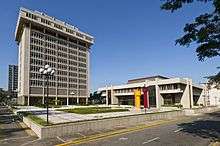Central Bank of the Dominican Republic

The Central Bank of the Dominican Republic (Spanish: Banco Central de la República Dominicana, BCRD) was established by the Monetary and Banking Law of 1947 as the central bank of the Dominican Republic, responsible for regulating the country's monetary and banking system.The Banks headquarter is in Santo Domingo and current governor is Héctor Valdez Albizu.[1][2]
Establishment and Objectives
Organic Law no. 6142 of December 29, 1962, authorized the central bank to promote and maintain favorable monetary, foreign exchange and credit conditions for the stability and development of the national economy. The central bank's functions include regulating market liquidity levels by: determining deposit reserve requirements for banks; implementing lending limits when necessary; and issuing negotiable securities. Additional functions include controlling movements of the exchange rate and introducing resolutions pertaining to the financial system.
Activities and Structure
The BCRD implements all changes to banking regulation proposed by the Monetary Board (Junta Monetaria) which is the highest body of authority within the institution. The Board consists of ten members, all of which are appointed by the executive. The governor of the central bank heads the Monetary Board while the Ministry of Finance and the Ministry of Industry and Commerce each have a seat on the Board. The BCRD Governor is appointed by the executive for a period of two years though with Héctor Valdez Albizu there has been continuity at this senior post for several years despite political administration changes. Albizu was the BCRD governor 1994-2000, and again holding the post since August, 2004.
Since late 1993, BCRD has worked with the sponsorship of the Inter-American Development Bank to improve several areas of banking practice.[3]
Performance and Reform Since the 1990s
Monetary policy during the 1990s was conducted within a framework of limited central bank autonomy and a managed floating exchange rate regime. A key objective of the BCDR was price stability in conjunction with real output growth and reserve accumulation, such that the stock of BCRD net domestic assets became the targeted policy instrument. Liquidity was managed directly through credit controls and freezing asset reserves. BCRD also intervened in the private foreign exchange market, smoothing the volatility of the exchange rate. However, the monetary authorities recently moved towards the interest rate as its indirect monetary policy instrument, namely through issuing central bank paper (certificados de participacion), with prices determined at auction.
The macroeconomic situation suffered a major shock in 2003 with the banking crisis and subsequent bail out by the BCRD, which guaranteed all Baninter (one of the major banks that failed) deposits and providing liquidity to two other banks at a total cost to the budget equivalent to 21 percent of the GDP. The banking crisis led to a major capital flight, a sharp currency depreciation, high inflation and significant fiscal pressures (exacerbated by an ongoing electricity crisis), together creating large macroeconomic imbalances and an environment of uncertainty and perceived risk. In October 2003 the BCRD raised the commission on foreign exchange transactions for purchasing imported goods to 10 percent and subsequently to 13 percent at the beginning of 2005.[4]
See also
Banks of the Dominican Republic
Notes
- ↑ "BCRD - About CB". www.bancentral.gov.do. Retrieved 2016-09-10.
- ↑ "CBDR - About CB". www.bancentral.gov.do. Retrieved 2016-09-10.
- ↑ The Dominican Republic Banking System, Fitch Ratings, December 2002
- ↑ Dominican Republic: Review of Trade and Labor Competitiveness, World Bank 2005
External links
| Wikimedia Commons has media related to Banco Central de la República Dominicana. |
- (Spanish) (English) Central Bank of the Dominican Republic official site
